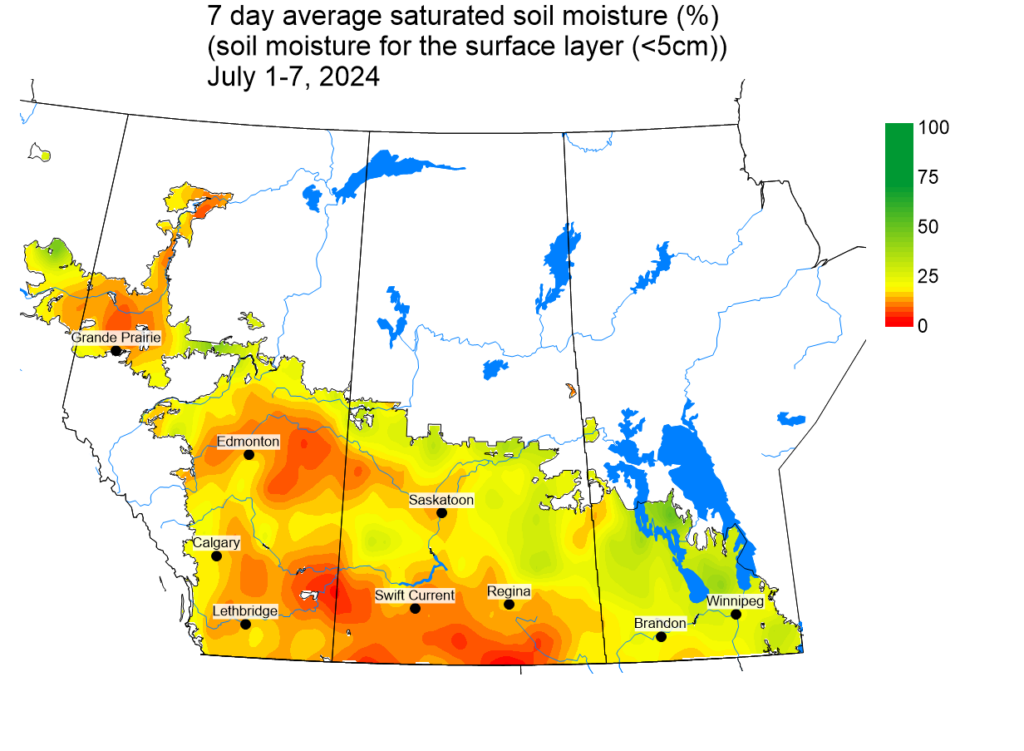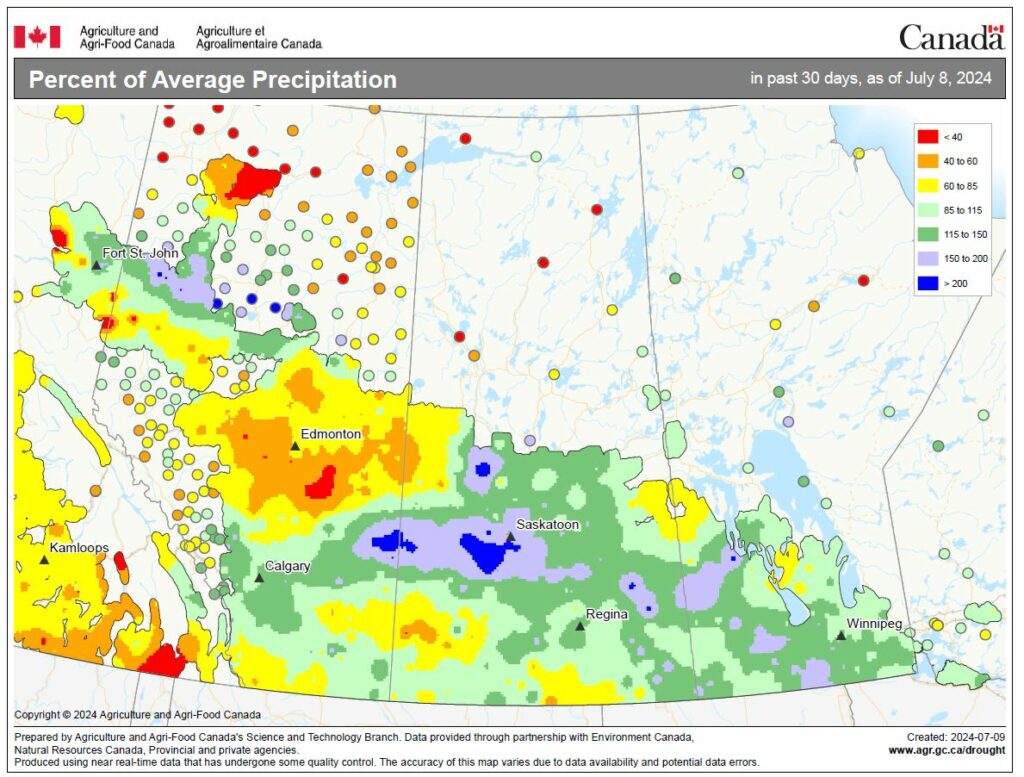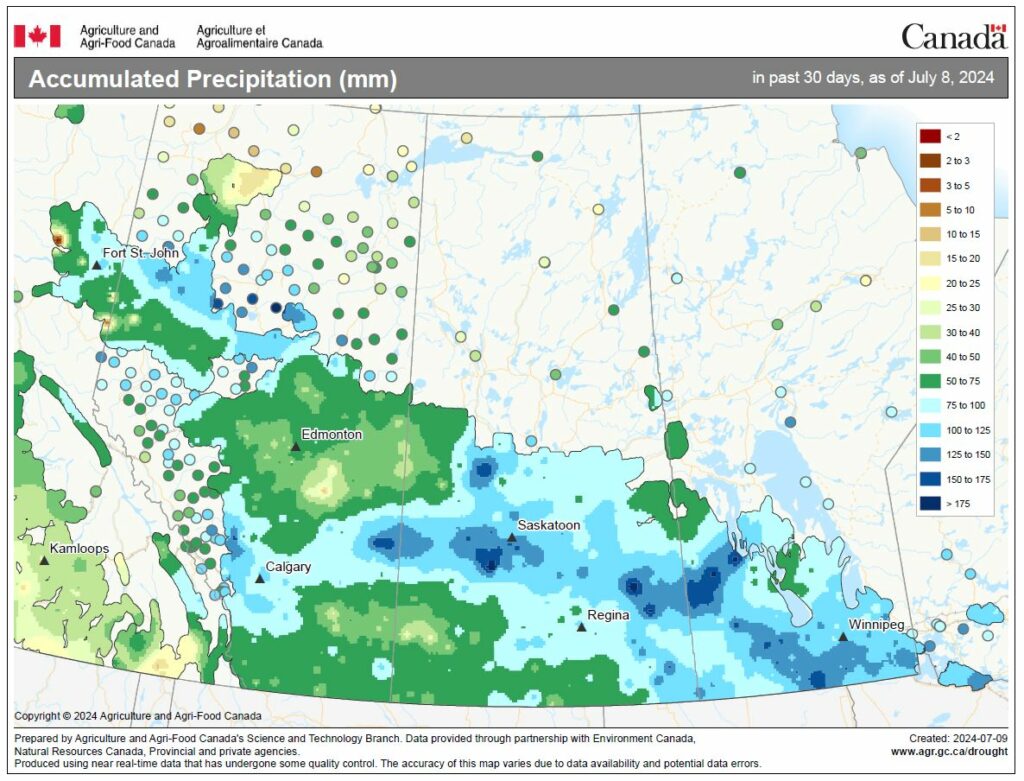This is the third weekly PCDMN soil moisture update in relation to the risk of sclerotinia sclerotial germination and potential risk of stem rot of canola. For details on the background of these updates please visit the first and second weekly updates for 2024 for background on the maps and information on sclerotinia risk assessment.
Soil moisture values, particularly near the soil surface, can impact sclerotial germination. Figure 1 presents data to show soil moisture levels (averaged for July 1-7) in the top five centimeters of soil in western Canada. The driest soil moisture conditions were observed for broad areas in Alberta and Saskatchewan. Soil moisture values were greatest for Manitoba and the Parkland/northeastern region of Saskatchewan. Figures 2 and 3 provide context in relation to percentage of average precipitation and accumulated precipitation in the past 30 days as of July 8, 2024. It illustrates that Manitoba and the Parkland region have received the most precipitation and thus likely have soil moisture conditions conducive to sclerotial germination. Note Figures 2 and 3 are courtesy of Agriculture and Agri-Food Canada’s Science and Technology Branch. Data provided through partnership with Environment Canada, Natural Resources Canada, Provincial and private agencies.
Note, hot dry conditions that predominated across many of the Prairies over the past week as of July 14, 2024 would have hastened canola development and shortened the flowering period in many crops. In addition, these conditions would have helped to dry out crops and soil surfaces, especially in areas that did not receive the same amounts and frequency of rainfall as Manitoba and the Parkland region. Given this recent hot weather, the Canola Council of Canada posted a very useful Canola Watch article on the impact of hot weather on fungicide performance.
The data is produced from passive microwave satellite data collected by the Soil Moisture and Ocean Salinity (SMOS) satellite and converted to soil moisture using the SMOS soil moisture processor. The data are produced by the European Space Agency. Satellites are used to sense the strength of radiation emitted from the surface of the earth. There is a strong difference in the signals emitted by dry soil and wet soil. This relationship is used to calculate surface soil moisture using a model that incorporates land cover, vegetation content, surface roughness, soil texture and other factors that influence the satellite sensor. The satellite collects data every one to three days over Canada (Satellite Soil Moisture – agriculture.canada.ca).
Prairie canola growth stages for 2024 are variable depending on the Province, region, and seeding date. In many regions crops are starting to flower or are well into the flowering period. For wetter regions, conditions have been favourable for germination of sclerotia and production of apothecia over the last 1-3 weeks. However, in drier areas localized weather systems may have helped to initiate sclerotial germination and eventual production of apothecia over the next 2-3 weeks. As of July 7, the need to scout fields for apothecia of the stem rot fungus and/or to assess in-field risk is low to moderate, although the risk is higher in regions where moisture conditions have been increased over the last 1-3 weeks, e.g. Manitoba and northeastern Saskatchewan. Again, localized weather systems (e.g. thunderstorms and associated rainfall) may increase the risk in other Prairie regions. Scouting is especially important where crop canopies have covered the soil surface for at least 2-4 weeks.
In 2006, the Canola Council of Canada and Agriculture and Agri-Food Canada co-developed a canola disease identification card that includes examples of typical stem rot pathogen apothecia along with other fungal fruiting structures that are not stem rot apothecia.
In these higher risk areas in-crop scouting for apothecia and the use of available stem rot risk assessment tools may be needed over the next 1-3 weeks as part of fungicide use decisions. Tools such as the Spornado spore trap and petal testing services (service 1 and service 2) can provide guidance related to the level of sclerotinia inoculum and stem rot risk as the crop starts flowering. Note these need to be combined with other risk tools to provide a complete picture of stem rot risk in relation to host, pathogen and environment factors, i.e. the disease triangle. If fungicides are being considered, accounting for the most common crop growth stage in a field should be considered to help guide the timing(s) used. Fortunately, most fungicide products have a window from 20-50% bloom, which represents a range of growth stages. Note available risk assessment tools will provide guidance related to stem rot risk and whether a fungicide is needed from 20-50% bloom.
On June 26, 2024, a new web-based tool from the Canola Council of Canada was recently announced that considers host, pathogen and weather related stem rot risk factors as well as a component that evaluates ROIs based on input costs, projected yields and commodity price. More information on the tool can be found at the Canola Council of Canada, along with the online tool itself.
Also mentioned in the June 23-30 soil moisture update were the “wet pants” test and the availability of a relative humidity based sclerotinia risk tool from Ralph Wright, Alberta Agriculture and Irrigation and based on a risk system from the UK. These provide additional information related to the favourability of weather conditions for stem rot risk. Note this information should be combined with the assessment of other plant disease triangle components, i.e. the pathogen and host to provide a better overview of stem rot risk.




